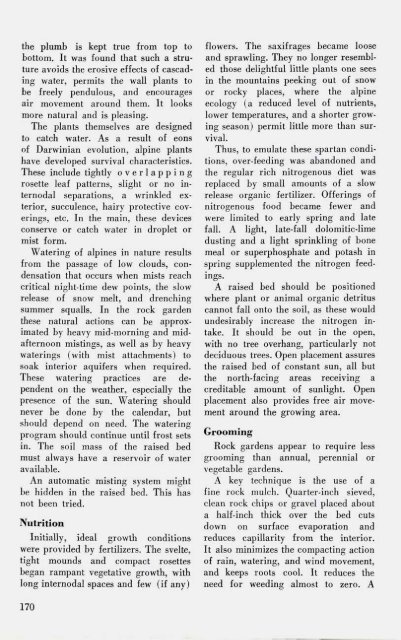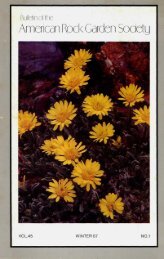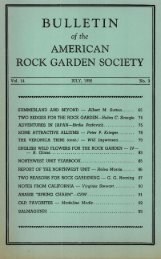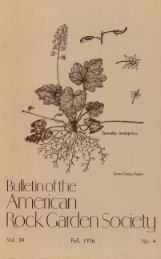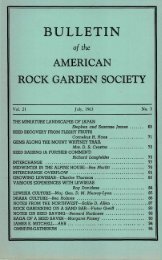Bulletin - Fall 1979 - North American Rock Garden Society
Bulletin - Fall 1979 - North American Rock Garden Society
Bulletin - Fall 1979 - North American Rock Garden Society
You also want an ePaper? Increase the reach of your titles
YUMPU automatically turns print PDFs into web optimized ePapers that Google loves.
the plumb is kept true from top tobottom. It was found that such a strutureavoids the erosive effects of cascadingwater, permits the wall plants tobe freely pendulous, and encouragesair movement around them. It looksmore natural and is pleasing.The plants themselves are designedto catch water. As a result of eonsof Darwinian evolution, alpine plantshave developed survival characteristics.These include tightly overlappingrosette leaf patterns, slight or no internodalseparations, a wrinkled exterior,succulence, hairy protective coverings,etc. In the main, these devicesconserve or catch water in droplet ormist form.Watering of alpines in nature resultsfrom the passage of low clouds, condensationthat occurs when mists reachcritical night-time dew points, the slowrelease of snow melt, and drenchingsummer squalls. In the rock gardenthese natural actions can be approximatedby heavy mid-morning and midafternoonmistings, as well as by heavywaterings (with mist attachments) tosoak interior aquifers when required.These watering practices are dependenton the weather, especially thepresence of the sun. Watering shouldnever be done by the calendar, butshould depend on need. The wateringprogram should continue until frost setsin. The soil mass of the raised bedmust always have a reservoir of wateravailable.An automatic misting system mightbe hidden in the raised bed. This hasnot been tried.NutritionInitially, ideal growth conditionswere provided by fertilizers. The svelte,tight mounds and compact rosettesbegan rampant vegetative growth, withlong internodal spaces and few (if any)flowers. The saxifrages became looseand sprawling. They no longer resembledthose delightful little plants one seesin the mountains peeking out of snowor rocky places, where the alpineecology (a reduced level of nutrients,lower temperatures, and a shorter growingseason) permit little more than survival.Thus, to emulate these spartan conditions,over-feeding was abandoned andthe regular rich nitrogenous diet wasreplaced by small amounts of a slowrelease organic fertilizer. Offerings ofnitrogenous food became fewer andwere limited to early spring and latefall. A light, late-fall dolomitic-limedusting and a light sprinkling of bonemeal or superphosphate and potash inspring supplemented the nitrogen feedings.A raised bed should be positionedwhere plant or animal organic detrituscannot fall onto the soil, as these wouldundesirably increase the nitrogen intake.It should be out in the open,with no tree overhang, particularly notdeciduous trees. Open placement assuresthe raised bed of constant sun, all butthe north-facing areas receiving acreditable amount of sunlight. Openplacement also provides free air movementaround the growing area.Grooming<strong>Rock</strong> gardens appear to require lessgrooming than annual, perennial orvegetable gardens.A key technique is the use of afine rock mulch. Quarter-inch sieved,clean rock chips or gravel placed abouta half-inch thick over the bed cutsdown on surface evaporation andreduces capillarity from the interior.It also minimizes the compacting actionof rain, watering, and wind movement,and keeps roots cool. It reduces theneed for weeding almost to zero. A170


